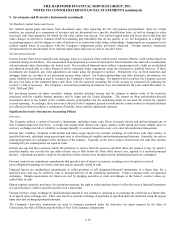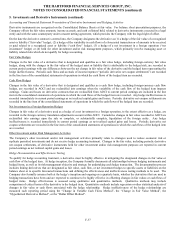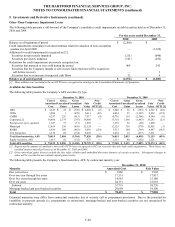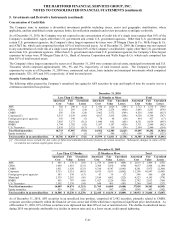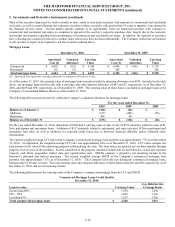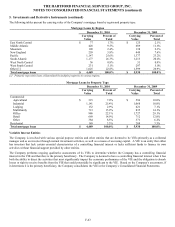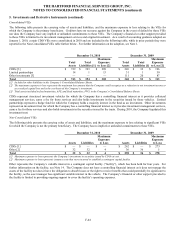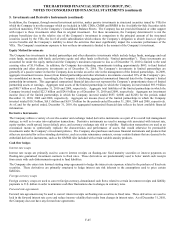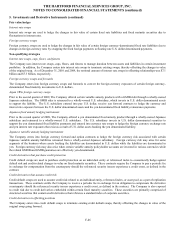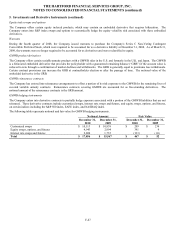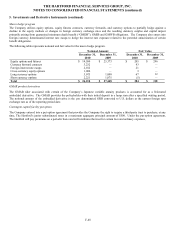The Hartford 2010 Annual Report Download - page 174
Download and view the complete annual report
Please find page 174 of the 2010 The Hartford annual report below. You can navigate through the pages in the report by either clicking on the pages listed below, or by using the keyword search tool below to find specific information within the annual report.THE HARTFORD FINANCIAL SERVICES GROUP, INC.
NOTES TO CONSOLIDATED FINANCIAL STATEMENTS (continued)
F-46
5. Investments and Derivative Instruments (continued)
Fair value hedges
Interest rate swaps
Interest rate swaps are used to hedge the changes in fair value of certain fixed rate liabilities and fixed maturity securities due to
fluctuations in interest rates.
Foreign currency swaps
Foreign currency swaps are used to hedge the changes in fair value of certain foreign currency-denominated fixed rate liabilities due to
changes in foreign currency rates by swapping the fixed foreign payments to floating rate U.S. dollar denominated payments.
Non-qualifying strategies
Interest rate swaps, caps, floors, and futures
The Company uses interest rate swaps, caps, floors, and futures to manage duration between assets and liabilities in certain investment
portfolios. In addition, the Company enters into interest rate swaps to terminate existing swaps, thereby offsetting the changes in value
of the original swap. As of December 31, 2010 and 2009, the notional amount of interest rate swaps in offsetting relationships was $7.1
billion and $7.3 billion, respectively.
Foreign currency swaps and forwards
The Company enters into foreign currency swaps and forwards to convert the foreign currency exposures of certain foreign currency-
denominated fixed maturity investments to U.S. dollars.
Japan 3Win foreign currency swaps
Prior to the second quarter of 2009, The Company offered certain variable annuity products with a GMIB rider through a wholly-owned
Japanese subsidiary. The GMIB rider is reinsured to a wholly-owned U.S. subsidiary, which invests in U.S. dollar denominated assets
to support the liability. The U.S. subsidiary entered into pay U.S. dollar, receive yen forward contracts to hedge the currency and
interest rate exposure between the U.S. dollar denominated assets and the yen denominated fixed liability reinsurance payments.
Japanese fixed annuity hedging instruments
Prior to the second quarter of 2009, The Company offered a yen denominated fixed annuity product through a wholly-owned Japanese
subsidiary and reinsured to a wholly-owned U.S. subsidiary. The U.S. subsidiary invests in U.S. dollar denominated securities to
support the yen denominated fixed liability payments and entered into currency rate swaps to hedge the foreign currency exchange rate
and yen interest rate exposures that exist as a result of U.S. dollar assets backing the yen denominated liability.
Japanese variable annuity hedging instruments
The Company enters into foreign currency forward and option contracts to hedge the foreign currency risk associated with certain
Japanese variable annuity liabilities reinsured from a wholly-owned Japanese subsidiary. Foreign currency risk may arise for some
segments of the business where assets backing the liabilities are denominated in U.S. dollars while the liabilities are denominated in
yen. Foreign currency risk may also arise when certain variable annuity policyholder accounts are invested in various currencies while
the related GMDB and GMIB guarantees are effectively yen-denominated.
Credit derivatives that purchase credit protection
Credit default swaps are used to purchase credit protection on an individual entity or referenced index to economically hedge against
default risk and credit-related changes in value on fixed maturity securities. These contracts require the Company to pay a periodic fee
in exchange for compensation from the counterparty should the referenced security issuers experience a credit event, as defined in the
contract.
Credit derivatives that assume credit risk
Credit default swaps are used to assume credit risk related to an individual entity, referenced index, or asset pool, as a part of replication
transactions. These contracts entitle the Company to receive a periodic fee in exchange for an obligation to compensate the derivative
counterparty should the referenced security issuers experience a credit event, as defined in the contract. The Company is also exposed
to credit risk due to credit derivatives embedded within certain fixed maturity securities. These securities are primarily comprised of
structured securities that contain credit derivatives that reference a standard index of corporate securities.
Credit derivatives in offsetting positions
The Company enters into credit default swaps to terminate existing credit default swaps, thereby offsetting the changes in value of the
original swap going forward.


